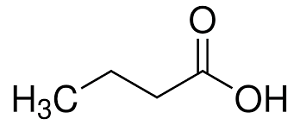Butyric Acid

Product Description
Butyric acid, also known as butanoic acid, is a carboxylic acid commonly used in various industrial applications due to its unique properties and versatile nature.
Product:
Butyric Acid
CAS:
107-92-6
Synonym:
Butanoic acid; 1-Propanecarboxylic acid
Structure:

Typical Characteristics
Appearance
Colorless oily liquid
Boiling point
163.5 °C
Density
0.958 g/cm3
Flash Point
72 °C
Melting point
-7.9 °C
Molecular Weight
88.11
Odor
Unpleasant, rancid odor
Purity
≥99%
Refractive index
1.398
Uses, Applications & Markets
Key applications
get a quote
We Offer Butyric Acid
in various grades
A few of the grades available are listed below:



Butyric Acid used in many
industry applications
Butyric acid, also known as butanoic acid, is a carboxylic acid with the chemical formula C4H8O2. It is commonly used in various industrial applications due to its unique properties and versatile nature. Here are some of its industrial uses:
- Food Flavoring: Butyric acid is utilized as a flavoring agent in the food industry, imparting a distinctive, slightly rancid odor and taste. It is often added to dairy products, such as butter and cheese, to enhance their flavor profile.
- Pharmaceuticals: In pharmaceutical formulations, butyric acid may serve as a precursor or intermediate in the synthesis of various active pharmaceutical ingredients (APIs) and drug compounds. It can also be used as an excipient or additive in drug formulations for its solubilizing or preservative properties.
- Chemical Synthesis: Butyric acid is a valuable building block in organic synthesis, serving as a precursor to numerous chemical compounds and derivatives. It participates in esterification reactions to produce butyrate esters, which have applications in fragrance, flavor, and plasticizer industries.
- Animal Feed Additive: Butyric acid and its salts (butyrates) are often included in animal feed formulations as feed additives or supplements. They serve as energy sources for livestock and poultry, promoting gut health and enhancing nutrient absorption, particularly in young or stressed animals.
- Biotechnology: Butyric acid is employed in various biotechnological processes, including fermentation and microbial synthesis. It serves as a carbon source for microorganisms in the production of biochemicals, biofuels, and biopolymers, contributing to the sustainable production of renewable resources.
- Perfumery: Due to its distinctive odor profile, butyric acid may find application in the perfumery and fragrance industry. It can be used as a component of fragrance formulations to impart certain olfactory notes or to mimic natural scents, enhancing the overall fragrance composition.
- Waste Treatment: Butyric acid is generated as a metabolic byproduct in various organic waste streams, including sewage sludge and agricultural residues. It can be utilized as a substrate in anaerobic digestion processes or microbial fermentation to produce biogas or other value-added products.
- Textile Processing: In textile manufacturing, butyric acid may be employed as a dyeing auxiliary or finishing agent to improve the dye uptake, color fastness, or softness of textile materials. It can also serve as a lubricant or sizing agent in fiber processing operations.